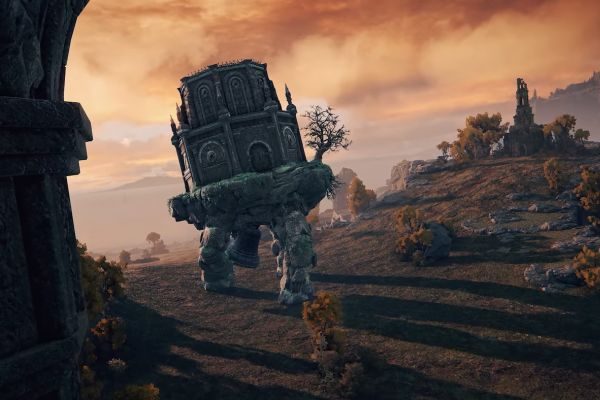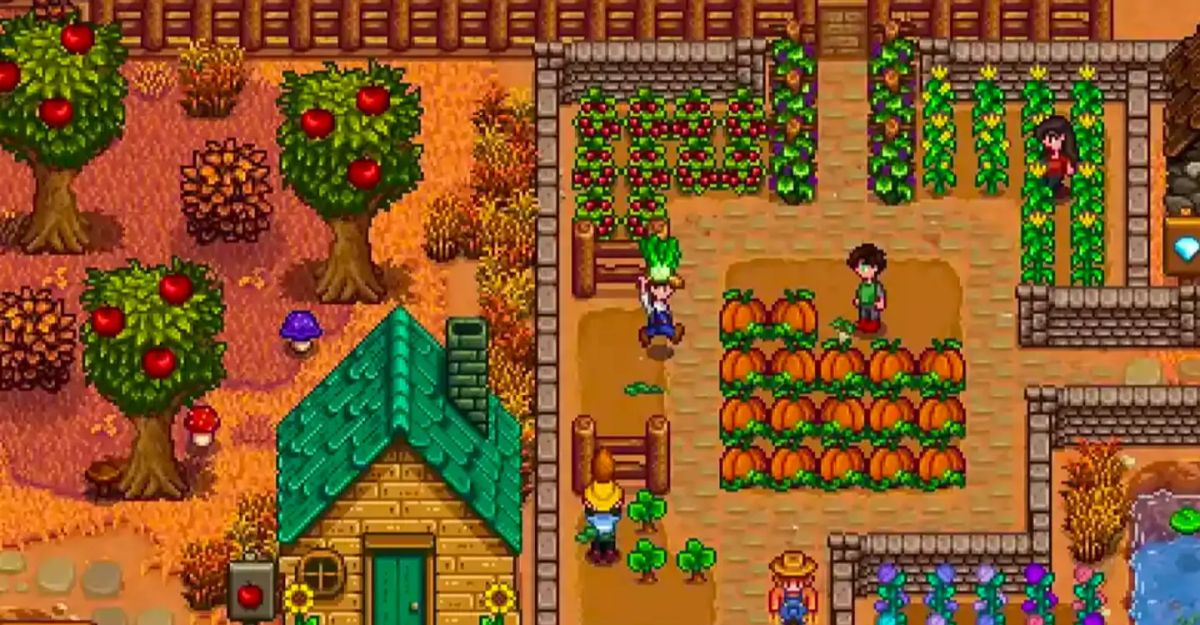As part of their manifesto, LA game design collective Arkane Kids claim that ‘the purpose of gameplay is to hide secrets‘. It remains, I think, one of the clearest statements of what is actually special about videogames. I’m highly skeptical of any claims about videogame exceptionalism when it comes to expression or storytelling, but there is something particularly powerful about the ability of a videogame to hide a secret from its audience. Videogames can hide secrets down paths not travelled, or behind particular combinations of buttons the player has never been told to press, or deep within a menu system. Finding a game’s secrets can lead to the medium’s most powerful moments, and not being able to find a game’s secrets can lead to the medium’s greatest frustrations.
Since its release at the end of February, I have been unearthing secrets in From Software’s Elden Ring for over 200 hours. A simple measurement of time tells you nothing about the quality of this game—one of my favourite videogames, Queers in Love at the End of the World, is ten seconds long. However, these 200 hours fascinate me because I never play a videogame for that long. It speaks to how Elden Ring has absorbed me like few other titles in my quest to discover all its secrets, to make sense of its world, to understand and map it. Elden Ring is a big game, yes, but more importantly it is an intricate and deliberately obtuse one in the way it hides its many secrets.
In Elden Ring, two design legacies collide in a way that is highly conducive to hiding secrets: the design conventions of From Software games, and those of open world games.
While not a singular franchise per se, ‘FromSoft’ titles since 2009’s Demon’s Souls—including Dark Souls and its direct sequels, Bloodbourne, and Sekiro—have shared stylistic traits that have developed a dedicated and ever-growing fan base. Each game in the sort-of-franchise is a third-person action game in which the player explores stunning, unique, and labyrinthine fantasy worlds; fights challenging and powerful enemies; meets mysterious friends and allies that rarely give a straightforward answer; and dies a lot.
FromSoft games are renown for being hard. Whereas conventional contemporary game design says that the player should be provided with the training and ability to never fail, FromSoft games hark back to a previous era of game design orthodoxy that provides this training through failure. Enemies are strong, and even a lowly rat can easily kill an experienced player who gets careless for a moment. Many encounters, especially boss battles, all but demand the player dies several times in order to learn how to achieve. This sense of difficulty has long been embraced by the games’ marketers to appeal to a masochistic and masculinist hardcore player base—the backcover of Dark Souls goaded the player in big red letters to ‘PREPARE TO DIE’—and has given FromSoft’s games a more general notoriety.
But the fact these games are hard is almost a misrepresentation of what they do so well. Firstly, it assumes a singular, objective metric of difficulty. Any game could be made ‘harder’ by giving enemies more health and making them do more damage. But that doesn’t necessarily make a game more engaging or rewarding; it might just make it more tedious or frustrating. FromSoft games, Elden Ring included, are not simply hard, but are designed around failure and repetition in particular ways.
There are two different ways videogames can deal with player death: one is to move time backwards (to the last checkpoint, the last autosave, etc), or to move time forward (teleporting the player to a previous checkpoint, but not undoing actions in the world). FromSoft games do the latter, and so give death a sense of progression, not a sense of punishment. The most consistent mechanical trait of FromSoft games, that has since been imitated much more broadly, is the system where, upon death, the player drops all their accumulated currency and must retrace their steps to get it back; if they die before they reach their own corpse, that currency is lost for good. This gives a sense of permanency and gravity to the games even as they are otherwise incredibly forgiving: you might never lose progress towards the game’s conclusion, a defeated boss will remain defeated, an unlocked door will remain unlocked, but you will never get back the two hours you spent grinding to finally level up before losing it all. Thus, the games feel hard and unforgiving, since a tangible and permanent punishment for failure constantly hangs over you, but they are simultaneously forgiving and generous in the ways they don’t punish you.
It’s not just the combat that is challenging. All aspects of these games are obtuse and standoffish. Items found in the game will give the player little explanation as to what they actually do. Important pathways will be hidden, deliberately, out of the way behind a wall or tree. Friendly characters met on the road will ask the player to make a decision seemingly loaded with game-changing significance and permanence with very little context. To play a FromSoft game is to be confused and overwhelmed, stressed that you have gone the wrong way or made the wrong decision without knowing it. Whereas most games make the consequences of your actions clear before you take them, FromSoft games often only reveal the consequences after you have already made the choice.
I think often of a knight in Dark Souls I encountered at the top of a tower near the start of that game. He was clearly very powerful, but he just stood there, with his arms folded, looking out at the horizon, paying me no attention. I attacked him and, of course, was immediately destroyed. But until I tried to attack him, he ignored me. This is how FromSoft games treat the player more generally: they stand back, arms folded, and wait for you to make the first move. If a giant or a knight or a ball of tentacles clobbers you into the ground, it’s probably because you approached it. This provides a strange, paradoxical empowerment in failure: you chose to be here; you chose to hit this big knight on the head; what did you think was going to happen?

But there’s one other crucial aspect of FromSoft games that the focus on difficulty and skill overlooks: the importance of community. While the franchise’s most hardcore, masochistic, masculine gamer-fans mistakenly see the games as tests of individual grit and skill (with no small amount of help from marketers), they are, in fact, about a community working together to comprehend and overcome a deliberately unfair and obtuse game. Other players can be directly summoned into your world to help with particularly challenging boss battles, but just as important is the ability to leave messages for other players scribbled on the floor, warning about traps, pointing towards hidden treasures, revealing enemy weaknesses, or just sharing in the lament of a scary dark tunnel.
Beyond the confines of the games’ virtual worlds, too, players are expected to work together by developing wikis, sharing suggestions on Twitter and in YouTube videos, talking to friends. As game designer Matthew Seiji rightly said to me nearly a decade ago, FromSoft games are made for the social media age.
Before the rise of the ubiquitous internet, it was easier for a videogame to hide secrets. Secrets (and rumours of secrets) were shared on school ovals or between friends. In grade 8, I paid a kid $1.50 (my sausage roll money) to learn the item duplication glitch in Pokémon. Today, most game secrets are, within days of release, only a Google search away. While some see the obtuseness of FromSoft games as masochistic (or straight up bad) design, it also gives players permission to work together to figure out the game’s secrets. Instead of the internet destroying the game’s secrets, the internet becomes a central component to, collaboratively, excavating and understanding the game’s secrets. No use of a walkthrough or request for help feels like cheating when the game is working this hard against you. Anything goes.
All these traits of difficulty and obtuseness are as common in Elden Ring as its predecessors, but here are presented to the player on a whole different scale by combining the FromSoft formula with the open-world genre. In a sense, FromSoft games have long been ‘open worlds’ in that the majority of the player’s adventure takes place in continuous spaces rather than consecutive levels, giving the player some freedom to explore in the direction they choose. But the openness is much more pronounced in Elden Ring. After the game’s tutorials, the player walks out of a tomb into a grassy plain with multiple castles and ruins on the horizon, and a single path that just over the hill will soon split into two. There is a ‘suggested’ path, if you pay close attention to what the small handful of friendly characters have to say (I didn’t), but ultimately you can go where you please. Boss battles that other players encountered in their first hour, I didn’t discover until I’d been playing for a week.
The open-world genre has become something of a bloated, sick beast in the past decade. The commercial game industry’s desire to fill games with more and more content and systems and stories and assets that hold the player’s attention (and, increasingly, wallet) for as long as possible has led to a raft of open-world games lacking in coherency or basic creative direction. New games in Ubisoft’s Assassin’s Creed and Far Cry franchises in particular are exemplary of a more endemic design crisis: game maps full of hundreds of markers pointing to different collectives and questions and achievements; layer after layer of disorientating menus for different superfluous crafting systems; sometimes three or even five different in-game currencies earned in different ways and used in different stores to collected broadly similar cosmetic items; narratives that increasingly make no sense unless the player has been watching a web series for the six months leading up to the game’s release. Today, the largest blockbuster videogames—especially but not exclusively in the ‘open-world’ genre—are no longer buckets of homogenous content but oceans, with no discernible landmarks against which the player can orient themselves.
I found the pre-release marking material of Elden Ring, in the way it presented Elden Ring as ‘open-world FromSoft’ highly worrying for precisely this reason. The idea of FromSoft falling in line and open-worlding such a unique series of games was sure to homogenise and ruin what was so distinctive about them, turning Elden Ring into just another content ocean that loses all discernible features.
Thankfully, this didn’t happen. While there is undeniably a blandness to some of Elden Ring’s large early areas compared to the intricate streets of Bloodborne or bamboo forests of Sekiro, by and large From Software have used the open-world format to emphasise and expand the core experiences of playing a FromSoft game, rather than dilute them. In short, it provides the game with more space to hide more secrets.
If anything, the open-world structure makes Elden Ring one of the most accessible FromSoft games yet—and only the second I’ve managed to complete. Like my Dark Souls knight who stood back, arms folded, many of Elden Ring’s enemies are intimidating and daunting, but also entirely ignorable for the longest time if one gives them a wide birth. Thanks to the open structure, even crucial boss battles are no longer a bottleneck, as you can simply travel to another region of the map for a while instead.
But the open-world format also allows Elden Ring to double down on its obtuseness and obscurity. Whereas most open-world games today overwhelm, unintentionally, by providing markers and counters and progression metres for everything the player could do, Elden Ring overwhelms, intentionally, by refusing to provide any sense of just how much content is out there: how many encounters, how many locations, how many quests, etc. There’s no ‘completion tracker’ in a menu telling you what percentage of dungeons you still haven’t discovered. Even the game’s map provides no clear sense of how much of the game is left to explore, as it slowly zooms out further and further as the player pushes at its edges, giving a sense that it could just go on forever.
Nor is the world static, with encounters shifting or being triggered by the player crossing invisible lines elsewhere on the map. On my first play, a certain castle far to the east was completely empty, a daunting and eerie lonely walk up until the boss battle at its furthest point. On my second play, the castle was full of enemies, a whole garrison, as well as an extra boss battle I never saw on my first game. After researching online, it turns out the castle is always full of enemies unless you progress a certain distance in another direction without visiting it first. This imbued even my second play—usually one of predictability and refinement—with uncertainty and trepidation, feeling like the game could change things up on me at a moment’s notice.
Elden Ring is a master class of level design not just in how it leads the player to locations but in how it leads the player away from locations, forcing them to work against the lay of the land and the conventions of other games to find locations, giving a sense of achievement and discovery unusual for a hand-crafted game. Entire castles or forests or catacombs are hidden down the tiniest, most insignificant corridors or over small hills.
This goes against the conventional economics of blockbuster game design. The size of a game, the time it would take to finish, the number of quests and encounters, all such facts are usually fodder for the pre-release marketing campaign. In Elden Ring, after 200 hours I still don’t know the true answer to any of these. Everything is hidden until you discover it (by walking through the game or searching online to find a community of players who have). A typical game would ensure a major area of the game that cost thousands of developer hours to make can’t be missed. Elden Ring will deliberately hide it obtusely only for those keen-eyed—or, again, those working as part of a community to figure out the game’s secrets.
Its story is similarly obscure. While Elden Ring, like all FromSoft games, is built on the foundations of an incredibly intricate storyworld of mythical characters, factions, gods, mythologies, its plot—that is, its story as actually told to the player over the course of the game—is minimal and secondary to the more ambient wordbuilding and atmosphere. The plot, so much as it exists, is told through very occasional cut scenes, worldbuilding, bits and pieces of vague dialogue, and item descriptions deep in your inventory. Beyond the very surface level ‘you are trying to become Elden Lord by killing some guys’, I only know what is actually happening here through reading conversations online of other players discussing and debating the lore of the world—again, a reliance on the broader community to make sense of what is happening here. If most fantasy videogames are the equivalent of Lord of the Rings, Elden Ring is more like playing The Silmarillion: not a particularly engaging or conventional story, but a history textbook that helps you explore a mythical world that and make sense of what happened here, encountering legendary deities from history who have been apparently waiting for eons for you to show up.
If most videogames are collaborative stories that the player travels through and participates in, like an actor following their part of the script, Elden Ring is more like a complex puzzle box that players collectively poke at, trying to find a way into to figure out its secrets. It pretends to be about masochistic individual performance but is in fact about collaboration, helping each other out, and working against a deliberately obtuse and unfair opponent.
Overland’s Friday Features project is supported by the Copyright Agency’s Cultural Fund.




